Copy Right Anne Ibach 2021
(I’m really happy that a lot of people are making this bag! Since it’s free, when you post a photo of your bag on social media, please credit me, use the hashtag #frankenbag, and provide a link to this tutorial so others can find it.
Regarding selling bags you make from my tutorial… I’d rather that any sales are limited in number and are done locally and not through internet stores. Any sales should acknowledge my tutorial. Simply: Pattern by http://www.agilejack1.com. If you have questions about sales, please email me at anne@agilejack1.com. Thanks!!!)
I had so much fun making that quilted bag last night that I decided to make another one. I decided to document how I made it and share it here so you can make one of your own.
I’m calling this my Frankenbag because it’s made from a lot of spare parts! I dug into my orphan KFC blocks and crumb blocks to incorporate them here.
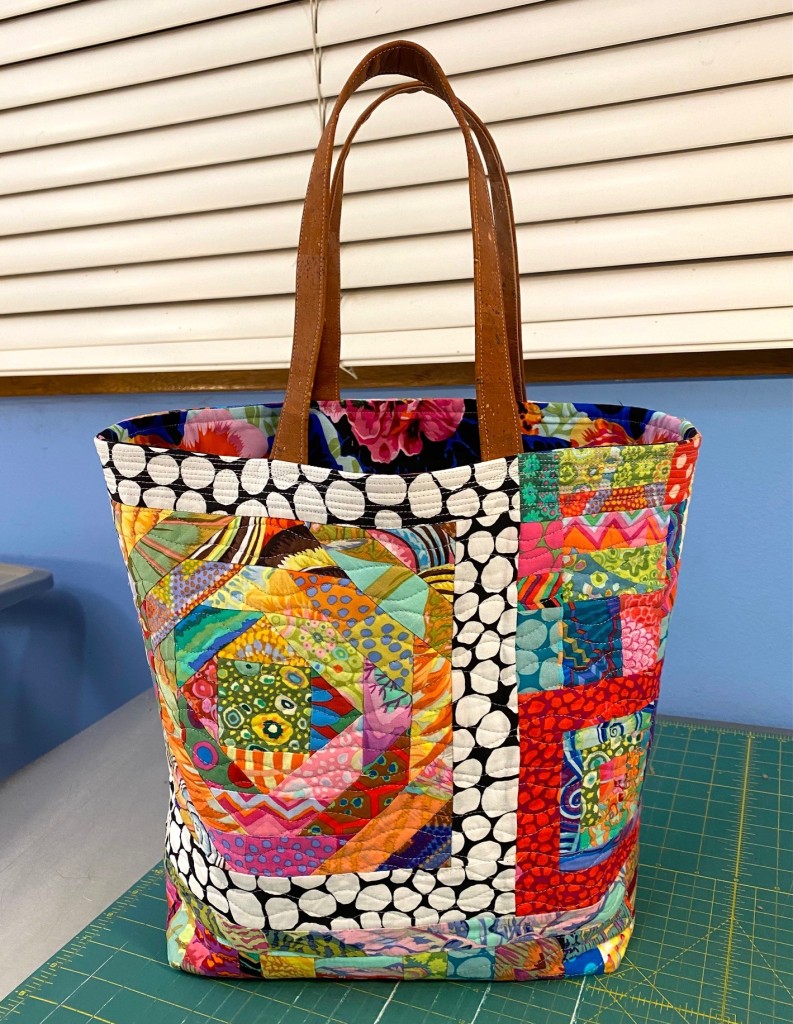
I think I like this one better than the first one I made! It’s about 13 inches high and 15 inches wide at the top edge. It’s a generous bag, but not TOO big. And it has a nice deep gusset. It will hold a lot of stuff.
Let’s dig in and make one! And a note to you… I’m writing this assuming you know basic sewing and construction techniques. But hopefully it will work for sewers of all skill levels.
Please read through this entire post before starting because I’ve added notes, updates and tips as I’ve made more of these bags.
If you would like to add a zipper placket to the top of your Frankenbag, see my zipper placket tutorial here.
Here’s the materials you need for this bag:
- Scraps or fabric to make the front and back of your bag. I made mine with crumb quilting and orphan blocks. You can use any technique you want to make your scraps into a panel, or use blocks you already have. You could even cut up a quilt to make one. This is a good opportunity to try something new!
- 1/2 yard of fabric for the lining. I love a lining that does my pieced panel justice! A nice pop of color or print in a lining is so much fun! Don’t skimp on the lining!
- 1/2 yard of fabric for the backing for your quilt sandwich when you quilt the front. This can be essentially any fabric as it will be hidden inside the bag. It’s a great way to use up larger scraps or fabric that you can’t imagine what made you buy it five years ago.
- 1/2 yard of fusible fleece or batting. (I’m currently using Pellon TP971F)
- Cork fabric that is large enough for you to cut 2 pieces at 3×18 inches each. For handles long enough to use as shoulder straps, you’ll need to cut your pieces 3×24 inches. (UPDATE: after I used the cork I had on hand, I had a difficult time finding cork that was the quality I wanted. So I switched to faux leather and am making the handles longer. I really like the faux leather much better than the cork. Scroll all the way to the bottom of this post for a link to the product I’m using and info on making the handles longer so they can be used for a shoulder bag.)
Make the Handles
Fold the cork fabric in thirds lengthwise and clip.

Stitch a line of top stitching along the long edge on each side of the handle.

Make the pieced panels for the front of the bag:
(Note: I used my time machine and went into the future and made a bit of a tutorial showing how I make these pieced panels. You can find it here.)
UPDATED JULY 6, 2022 — CLICK HERE TO SEE MY CRUMB PIECING TUTORIAL TO LEARN HOW I SELECT FABRICS AND SEW MY CRUMB BLOCKS. INCLUDES A VIDEO TUTORIAL.
Make a pieced panel of your choice. I used crumb piecing and some orphan blocks, bordered them with fabric and combined them in a really random way. You can use blocks you have on hand, or make some new blocks for this. You can do improv piecing, paper piecing, anything that floats your boat. This tutorial is written for a 17×17 inch square panel.
If you want to do some crumb pieced blocks, check out my blog post that includes some info on how I make mine. Or go to Youtube and search for “crumb block tutorial” and you’ll get some good options.
These panels are really the fun part for me! It’s a great opportunity to make something that you’ve always wanted to try. Just make sure that yours end up 17 inches square.
For my Frankenbag, one panel was all crumb pieced and the other one included some orphan blocks with crumb piecing. Here’s both panels:
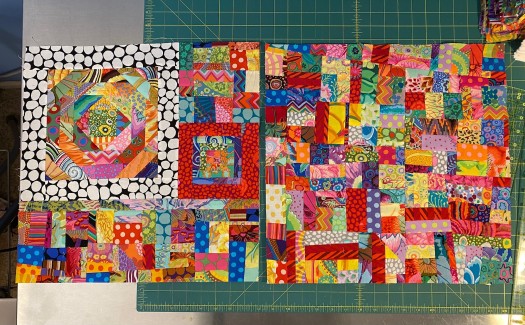
The panel on the right is all crumb piecing. The one on the left includes two orphan blocks. Here’s all the pieces I had available to use in this orphan panel:
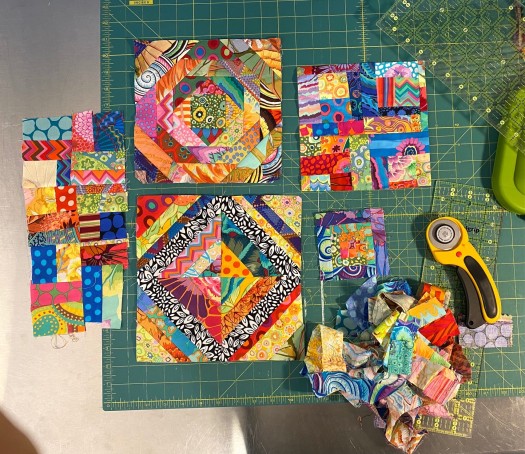
I chose the pineapple block and the small log cabin block. I put the black and white jumble border on the larger pineapple block, and a red guinea flower border on the smaller log cabin block.
This picture shows part way through putting this panel together. The next step was to sew the crumb piece at the bottom to the top part. As I put these together I kept in mind that 17 inch square I needed and put these pieces together with that in mind.
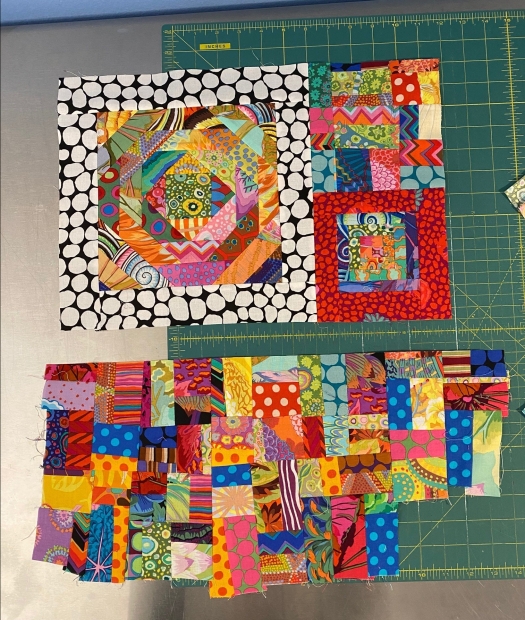
Once it was all sewed together, I trimmed it to 17 inches square.
Quilt your pieced panels
I used fusible fleece for my bag, but you can use any batting you like. The fleece was cut to about 18×18 inches and fused to the back of the pieced panel. If you’re using fusible fleece, be careful when using your iron on this. Keep your iron on the panel fabric and don’t get too close to the edge and melt the glue exposed glue on the fleece.
Then I cut a 19×19 piece of the fabric for the back of the quilt sandwich. I used two batik fat quarters that I’ve had laying around forever. Remember, the print on this fabric doesn’t matter because it will all be hidden inside the bag. It just adds some stability to your quilting.
Make your quilt sandwich with the backing fabric first, then the fleece and panel on top. I like to have the backing a little bigger than the fleece/batting, and have the panel a little smaller. This helps make sure that things don’t shift away from the edge as you’re quilting and you can be confident that all of your quilting will have batting and backing behind it.

I used some spray basting to adhere the backing to the fleece.
Quilt your panel in any way you like. I used my walking foot and did some matchstick quilting on the top 1.5 inches of each panel, and then used wavy horizontal lines for the remainder of the panel.

Use your favorite method, or try something new! It’s just a 17×17 inch piece of fabric! Nothing to lose if you mess it up!
Once you get your two panels quilted, trim away the extra batting and backing. Keep these as close to 17×17 as you can.

Next, cut out a 2.5 inch square from the bottom corners of both panels. This will become the gusset which makes the bottom of the bag flat.

Attach the handles to the quilted panels
I actually did this after I sewed the side seams on my bag, but it would be easier to do this prior to sewing the sides together.
On the wrong side of the panel, locate and mark (on the wrong side) the center of the top edge of each panel. Then measure 3 inches over on each side of the center and mark with a pen.
For shoulder length straps, measure over 4 inches from the center line.
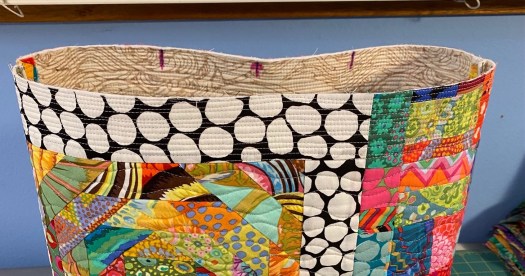
With the handles on the right side of the panel and the ends of the handles facing up, line up the handle inside the 3 inch mark (inside the 4 inch mark for longer handles). Leave about 1/4 inch of the handle edge sticking up beyond the top of the bag, Pin the handle securely in place. I use two pins.

Make sure your handle isn’t twisted. The same side of the handle should be against the panel on both sides. If you have the front side touching on one side and the back side on the other side, your handle will be twisted. Take some time to flip your handle up after you pin it to see if it looks right. I also put the two sides of the bag to make sure I have the handles placed the same on both sides. It’s a lot easier to fix it now than it would be after you stitch it!

Stitch the handles onto the panels. I just sew one long line from one handle to the next, making sure to go back and forth across each handle end a few times to reinforce it. Make sure that all of this stitching will be inside your final top stitching seam allowance so it won’t show.

Sew the sides and back of the panels
Put the two panels right sides together and pin the sides and bottom, and then sew along all three edges. I used a seam allowance of about 3/8 inches. You can use any seam allowance you like… quarter inch, or something larger. Just be sure to use the same seam allowance on all of the bag seams so your lining will fit the outside of the bag.

Press these seams open. I like the 3/8 inch seam allowance because it’ makes it easier to press these seams open. These panels are pretty thick, so pressing the seams open helps reduce bulk at the top of the bag.
Make the gussets
Push the side and bottom of the outside of the bag together until the side and bottom seams match and voila! You have a gussett! Make sure you have right sides together.

Line up the seams and pin the gusset. Sew it with the same seam allowance you’re using elsewhere. Be sure to back tack at the beginning and end, and be careful sewing over the seam allowances. It’s bulky and can be a needle breaker! Go slow!

Look at that beautiful gussett!
Make the lining and pocket
Take your half yard of lining fabric and cut the whole thing to 17 inches wide. Cut off the selvedge, cut a 17 inch square, and leave the section on the fold intact — this will become the pocket.
*******Lining update added 4/22/21*******
After making ten of these bags, I’ve found that the lining fits better if I cut it 16 & 3/4 inches wide and 16.5 inches high. The assembly is the same.

To make the pocket press the fabric to remove the fold. Fold the piece in half the other direction with right sides together.

Sew around three sides of this folded piece, leaving an opening large enough to turn the pocket right side out. Clip the corners and turn the pocket right side out. Gently push out all the corners and press the pocket, making sure to fold the seam allowances under at the opening. Topstitch across the top of the pocket. You get to choose the top! Your pocket should be close to square, or it may be a slight rectangle. Just decide which side you want to be the top.

Now cut a 2.5 inch square out of the bottom two corners of the lining pieces.

Take one piece of the lining and mark the center. Place the pocket on the right side of this fabric. Make sure it’s centered, and place it about 3 inches down from the top of the lining.
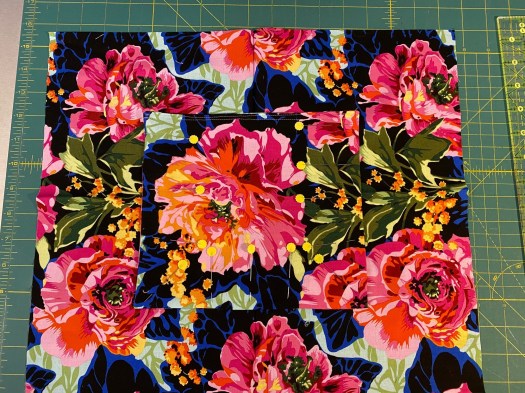
Pin it in place and stitch around the sides and bottom of the pocket. Back tack at the two top edges. (you can also sew an additional vertical line to divide the pocket, or make a thinner slot for a pen.)
Honestly, no one will ever know if your pocket is crooked, but you’ll feel better knowing it’s not on a slant.
Place the two lining pieces right sides together and pin. Sew the bottom seam and the two side seams, LEAVING A SIX INCH OPENING IN THE MIDDLE OF ONE SIDE SEAM. This is very important! This opening will allow you to turn the bag right side out after you attach the lining to the bag front. (It’s a good idea to press back the seam allowances on that opening now while the lining is flat. It will make closing it up later much easier.)
Press the seams open. Then make the gussets the same way you made the gussets on the outside of the bag.
Attach the lining to the bag front
You’re so close to being done!
Turn the bag front wrong side out and the lining right side out. Place the lining inside the bag. Your pieces should be right sides together at this point. Match and pin the side seams, and then pin all the way around the top edge of the bag, matching the top edges. (I have found that pinning with the pins facing the opposite direction from what the photo shows — with the points facing into the bag body — makes sewing this easier… I don’t get poked as much and it makes the pins easier to remove as I’m sewing.)

You can see the ends of the handles sticking up above the top of the bag. Don’t freak out. This is supposed to happen.
Your handles should be BETWEEN the outside of the bag and the lining. If they aren’t, stop now and figure out what the hell is going on!
Sew a seam all the way around the top of the bag. Back tack at the beginning and end of this seam. Be careful of all that bulk where the side seams meet and at the handles. . Speed kills at this point. And it eats needles!
Reach through the hole in the side of the lining and gently turn the bag right side out. Put your hand inside and push out all the bottom corners.
Line up the sides of the opening in the lining and pin it carefully. Stitch the opening closed very close to the edge, making sure you’re catching both sides.
Push the lining into the bag, smoothing and pushing the corners into the corners of the bag front.
Press the top of the bag so the seam is at the very top. Take a few minutes here to make sure this looks nice. This careful finishing makes a big difference in your bag.
Top stitch about 3/8 inch from the top of the bag. You can go back and forth at the handles again to reinforce them. it’s also a good idea to be mindful of all that bulk at this stage. Back tack at the beginning and end of this top stitching.
AND YOU’RE DONE!!! I hope you end up with a bag you love! I’d love to see a photo of your bag if you make this. You can email me at anne@agilejack1.com and when you post photos on social media, use the hashtag #frankenbag.
Leave me a comment if you have a question, or if you find an error.
NOTES ADDED ON 4-4-2021 TO ALTER THE HANDLES, and where to buy faux leather.
The first four Frankenbags I made had cork handles. And that was all the cork I had. So I went online and found some at Fabric.com. When it arrived I realized it was really thin and didn’t feel like it would hold up with use. So I went online and looked for other options.
I ordered some faux leather and I really like how it worked up. And it’s not terribly expensive. You can buy it by the yard. Here’s a link to the faux leather I purchased and Used on this bag.
On this border collie bag linked above I made the handles longer so they would comfortably go over my shoulder but they still work to carry with your hand. I altered the handle instructions included in this tutorial in two ways:
- I cut the faux leather 3 inches wide and 24 inches long.
- I marked four inches from the center of the bag to place the handles, rather than three inches.

Such and excellent tutorial and fun to make bag!!
LikeLiked by 1 person
Thank you! I’ve been inspired by what others are making.
Anne
LikeLike
I love your bag! For great quality cork that works perfect for bag making (including handles), go to sewmanycreationsny.com. I don’t buy cork anywhere else!
LikeLiked by 1 person
Thanks!
LikeLike
Do you sell your bags?
LikeLiked by 1 person
I do sell them. I don’t have available right now. I don’t have a shop because can’t make enough to keep one stocked. If you see something you like let me know and I can let you know if it’s available.
Anne
LikeLike
What fun! Thank you for the tutorials.
LikeLiked by 1 person
Thanks for reading!
Anne
LikeLike
I am not a “crumb sewer” ,but like the way you did them.
LikeLiked by 1 person
Oh man… I LOVE crumb piecing. it’s almost meditative for me. A great thing to do when you want to sew but are too tired for something that requires a lot of attention.
Anne
LikeLike
Hi, I have always wondered what to do with tiny scrap pieces and now I’m looking forward to making my first bag. Thank you.
LikeLiked by 1 person
These bags are great for scraps, but they don’t make much of a dent in MY scrap pile!
Anne
LikeLike
I love your work. Beautiful
LikeLiked by 1 person
Thank you!
Anne
LikeLike
Anne, will you please include a link to the instructions for adding the zippers to the Frankenbag? I just can’t get it right so maybe I am missing something.
LikeLike
this may be the best blog post I’ve ever read
am entering the quilting world, but want to make beautiful/fun/colorful things with purpose
this project hits all of that
LikeLiked by 1 person
Thanks! I’m glad you found me!
the thing I like about making the bags is that they allow me to explore an idea… a color combo… a new block… etc… without committing to a larger project. It’s a great way to identify the type of thing you like to make.
have fun with it!!
Anne
LikeLike
…. and i just noticed the blog’s subtitle — dogs quilting, profanity
omg you have Borders, and profanity
where has this blog been in my life, know what my night reading will be tonight
LikeLiked by 2 people
the audience is split on the profanity thing. I’d like to include more because it’s in my nature. Not sure everyone appreciates it!!! But I appreciate that you appreciate it!
Thanks for reading!
LikeLiked by 1 person
Thank you very much for the great instructions! I’m just a beginner but I managed to complete a bag with your pattern and tutorials. Lots of fun and a cool bag as a finished product!
LikeLiked by 1 person
Oh! That’s good to know that a beginner was able to follow my tutorial! Way to go!!!
Anne
LikeLike
Love your bag, first time I made it I cut the size down for a smaller tote and added the recessed zipper top! When I can get my grandkids to help I’ll post the picture with the references like you’ve stated!
Now I want to make one about the size of you slightly smaller one (13” h x 15” w) do you remember the size you made the large squares to start with?
LikeLiked by 1 person
I make my bags with panels that are 17 x 17 inches. the size works really well for me.
Anne
LikeLike
Thank you for this tutorial. I just discovered you today! Yay for me. I will be making a bag soon. Thanks!
Cindy
LikeLiked by 1 person
thanks for reading! good luck with your bag!
Anne
LikeLike
Merci Anne je me suis régalée à te lire
Bravo 🍾🎈🎊🎉 toujours aussi active et douée bises de France 🇫🇷
LikeLike
Merci et merci d’avoir lu!
Anne
LikeLike
Wonderful tutorial for the Frankenbag! I have my front panel done already. I don’t have any fusible but I do have some Soft and Stable. Have you ever tried it? I used to make bags and had some left over. I am a long armer now, but fell in love with the crumb piecing and decided to give it a go.
LikeLiked by 1 person
I never have used the soft and stable. I should give it a try to see how I like it.
I love crumb piecing! It’s really brainless and fun sewing for me.
Anne
LikeLike
I’ve had a blast making the panels. They are both finished. The faux leather isn’t due until the end of the month. I will pick up some Soft and Stable this weekend and give it a try. Thanks again for the tutorial!
LikeLiked by 1 person
Thank you for your tutorial! Our Quilt members are each making a Frankenbag for our Christmas exchange. I couldn’t have made it without your pictures and blog!
LikeLiked by 1 person
Oh! How fun!!! the exchange is such a fun idea!
Anne
LikeLike
I like so much your bags. I’m going to sew one with your tutorial. But I miss black and white fabrics. That makes an original style and enhance the colours. What is the label of these black and white fabrics? Thanks!
LikeLiked by 1 person
the black and white fabric in that bag is Brandon Mably’s jumble in white. He’s one of the designers in teh Kaffe Fassett Collective. I use that fabric a LOT. I just love it!
Anne
LikeLike